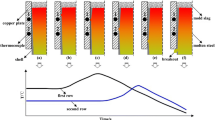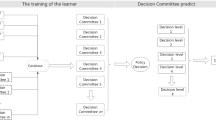Abstract
Breakout is a catastrophic accident in continuous casting. The existing breakout prediction methods based on logical judgment and neural networks need to constantly adjust the prediction parameters or prepare high-quality samples as the input, resulting in poor robustness and unstable precision stability. Therefore, it is particularly important to develop a breakout prediction method that not only can predict breakout accurately but also avoid human intervention significantly. This work proposes a novel approach for breakout prediction combining K-means clustering and feature dimension reduction. The method uses feature dimension reduction to obtain the typical feature vector (TFV) that can characterize the original temperature change trend, and then a K-means clustering model is established to realize online detection of breakout prediction. The results show that the model has a 100% alarm rate for the true breakout, and meanwhile, reduces the number of false alarms from 555 to 217 compared with the on-line breakout prediction system (BPS). The proposed method does not need to adjust the prediction parameters frequently or prepare the input samples carefully, which not only avoids the human intervention but also meets the requirements of online monitoring for the practicality and applicability of the breakout prediction method.














Similar content being viewed by others
References
Cheung N, Carcia A (2001) The use of a heuristic search technique for the optimization of quality of steel billets produced by continuous casting. Eng Appl Artif Intell 14(2):229–238. https://doi.org/10.1016/S0952-1976(00)00075-0
Kajitani T, Kato Y, Harada K, Saito K, Harashima K, Yamada W (2008) Mechanism of a hydrogen-induced sticker breakout in continuous casting of steel: influence of hydroxyl ions in Mould flux on heat transfer and lubrication in the continuous casting mould. ISIJ Int 48(9):1215–1224. https://doi.org/10.2355/isijinternational.48.1215
Roy PDS, Tiwari PK (2019) Knowledge discovery and predictive accuracy comparison of different classification algorithms for mould level fluctuation phenomenon in thin slab caster. J Intell Manuf 30(1):241–254. https://doi.org/10.1007/s10845-016-1242-x
Ma Y, Wang XD, Zang XY, Yao M, Zhang L, Ye SH (2010) Mould lubrication and friction behaviour with hydraulic oscillators in slab continuous casting. Ironmak Steelmak 37(2):112–118. https://doi.org/10.1179/030192309X12549935902347
Salah B, Zoheir M, Slimane Z, Jurgen B (2015) Inferential sensor-based adaptive principal components analysis of mould bath level for breakout defect detection and evaluation in continuous casting. Appl Soft Comput 34:120–128. https://doi.org/10.1016/j.asoc.2015.04.042
Zhang YX, Wang WL, Zhang HH (2016) Development of a mold cracking simulator: the study of breakout and crack formation in continuous casting. Metall Mater Trans B Process Metall Mater Process Sci 47(4):2244–2252. https://doi.org/10.1007/s11663-016-0705-y
Bhattacharya AK, Chithra K, Jatla SSVS, Srinivas PS (2004) Fuzzy diagnostics system for breakout prevention in continuous casting of steel. In: Proceeding of 5th World Congress on Intelligent Control and Automation, vol 4, pp 3141–3145
Liu Y, Wang XD, Du FM, Yao M, Gao YL, Wang FW, Wang JY (2017) Computer vision detection of mold breakout in slab continuous casting using an optimized neural network. Int J Adv Manuf Technol 88(1–4):557–564. https://doi.org/10.1007/s00170-016-8792-0
He F, Zhou L, Zheng ZH (2015) Novel mold breakout prediction and control technology in slab continuous casting. J Process Control 29:1–10. https://doi.org/10.1016/j.jprocont.2015.03.003
Duan HY, Wang XD, Bai Y, Yao M, Guo QT (2019) Application of k-means clustering for temperature timing characteristics in breakout prediction during continuous casting. Int J Adv Manuf Technol 106(11–12):4777–4787. https://doi.org/10.1007/s00170-019-04849-x
Chen GS, Zheng QZ (2018) Online chatter detection of the end milling based on wavelet packet transform and support vector machine recursive feature elimination. Int J Adv Manuf Technol 95(1–4):775–784. https://doi.org/10.1007/s00170-017-1242-9
Kanungo T, Mount DM, Netanyahu NS, Piatko CD, Silverman R, Wu AY (2002) An efficient k-means clustering algorithm: analysis and implementation. IEEE Trans Pattern Anal Mach Intell 24(7):881–892. https://doi.org/10.1109/TPAMI.2002.1017616
AOzturk MM, Cavusoglu U, Zengin A (2015) A novel defect prediction method for web pages using k-means plus. Expert Syst Appl 42(19):6496–6506. https://doi.org/10.1016/j.eswa.2015.03.013
Xu YJ, Qu MY, Li ZY, MIn GY, Li KQ, Liu ZB (2014) Efficient k-means plus approximation with MapReduce. IEEE Trans Parallel Distrib Syst 25(12):3135–3144. https://doi.org/10.1109/TPDS.2014.2306193
Acknowledgments
The Fundamental Research Funds for the Central Universities and the Key Laboratory of Solidification Control and Digital Preparation Technology (Liaoning Province) are gratefully acknowledged.
Funding
This work is supported by the National Natural Science Foundation of China (51974056/51474047/51704073).
Author information
Authors and Affiliations
Corresponding author
Additional information
Publisher’s note
Springer Nature remains neutral with regard to jurisdictional claims in published maps and institutional affiliations.
Rights and permissions
About this article
Cite this article
Duan, H., Wang, X., Bai, Y. et al. Modeling of breakout prediction approach integrating feature dimension reduction with K-means clustering for slab continuous casting. Int J Adv Manuf Technol 109, 2707–2718 (2020). https://doi.org/10.1007/s00170-020-05817-6
Received:
Accepted:
Published:
Issue Date:
DOI: https://doi.org/10.1007/s00170-020-05817-6




